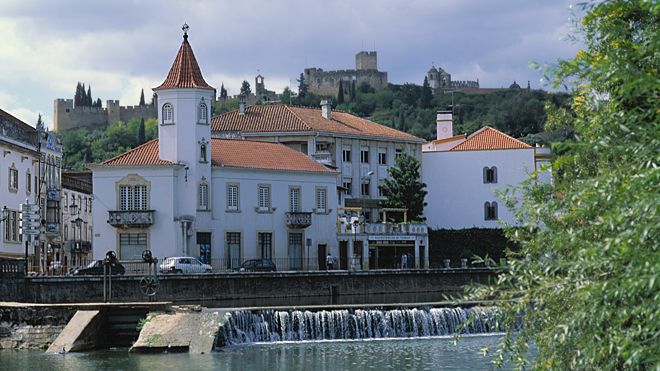
Tomar
Tomar, the former seat of the Knights Templar, is a charming city with a rich artistic and cultural heritage. The city's landmark, the Convent of Christ, is one of Portugal's most important Renaissance buildings.
Whatever your reason for visiting the city, be sure to visit the Templar Castle and the monumental Convent of Christ. The Charola is the oldest part. This Templar main chapel dates back to the 12th century, as does the castle, which at the time was the most modern and advanced military fortress in the kingdom, inspired by the fortifications of the Holy Land. The main chapel was converted into a chancel in the 16th century by order of King Manuel I. From that moment on, the complex acquired its magnificent splendor, which it preserves to this day and is recognized as a World Heritage Site.
Set aside plenty of time to visit the monastery and discover some of its treasures, such as the representations on the Renaissance portal, the symbolism of the Manueline window in the chapter house, the architectural details of the main cloister, and the rooms used for Templar rituals. To better understand its history, it's important to know that the Order of the Knights Templar was transformed into the Order of Christ, maintaining its power, knowledge, and wealth in Portugal. The famous Prince Henry, mentor of the Discoveries, was one of the order's most important administrators and patrons.
From the monastery, you can walk through the Mata dos Sete Montes to the historic center. If you follow the paved road, halfway along you'll find the chapel of Nossa Senhora da Conceição. This Renaissance gem was designed by the Portuguese João de Castilho, who also worked on the monastery.
Next, I recommend a visit to Tomar. The old medieval town is built in the shape of a cross, oriented to the four cardinal points, with a convent at each end. At its center is Praça da República, with the Church of São João Baptista. To the west, the hill with the castle and the Convent of Christ. In the streets surrounding the center, you'll find small shops and the oldest café, where you can still enjoy the delicious local sweets: almond queijadas, chila queijadas, and the traditional "Fatias de Tomar," a sweet made with egg yolks cooked in a bain-marie in a special cauldron. This cauldron was invented in the mid-20th century by a coppersmith from Tomar.
To the south lies the Convent of São Francisco, which today houses the remarkable Match Museum. To the north stands the former Convent of Anunciada. To the east, the Levada Museum. Here, you can still see the old mills powered by the Nabão River, which runs through the city. On one of its banks stands the Convent of Santa Iria. A little further on, in the same direction, stands the Church of Santa Maria do Olival, home to the tombs of several Templars, including that of Gualdim Pais, the order's first Grand Master, who died in 1195.
The entire city develops around this center, which is also the stage for one of the city's most important traditional events, the Festa dos Tabuleiros.
Tomar not only witnessed the Christian Reconquest in the 12th century, but also boasts an important testament to the Jewish faith: the ancient 15th-century synagogue. This synagogue currently houses the Abraão Zacuto Luso-Hebraic Museum, dedicated to the 15th-century astronomer and mathematician. This Luso-Hebraic museum, located on the old Rua da Judiaria, houses a valuable documentary and epigraphic collection. Note the holes in each corner, intended for the placement of terracotta jars to improve the space's acoustics.
Another attraction is the Contemporary Art Center, which houses the collection of one of the most important historians of 20th-century Portuguese art, Professor José-Augusto França.
Afterwards, you can take a break and relax from this cultural tour at Mouchão Park. Here, you'll see the Mouchão Wheel, one of the city's main attractions. It dates back to the time when the mills, oil mills, and fields along the river contributed to Tomar's economic prosperity.
There are other places to visit in the region, such as Castelo de Bode, home to one of the largest reservoirs in Portugal. Here, you can take a leisurely boat ride and enjoy lunch on board or enjoy various water sports. The small island in the Tagus River with Almourol Castle is also worth a visit, as is the small village of Dornes, which is of interest to those wishing to visit more Templar sites. For a more complete itinerary, we recommend checking out the World Heritage Routes – "In the Heart of Portugal." From Quinta da Palmeira – Country House Retreat & Spa, Batalha Monastery is an 85-minute drive away.